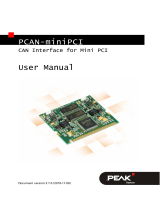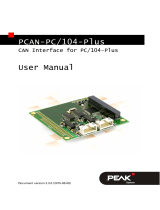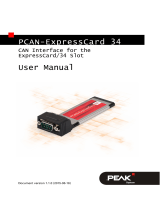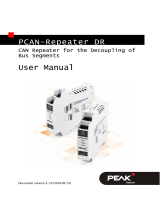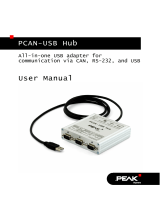Page is loading ...

PCAN-miniPCI
CAN Interface for Mini PCI
User Manual
Document version 2.4.0 (2015-06-10)

PCAN-miniPCI – User Manual
2
Products taken into account
Product Name Model Part number
PCAN-miniPCI Single Channel
One CAN channel IPEH-003044
PCAN-miniPCI Dual Channel Two CAN channels IPEH-003045
PCAN-miniPCI Single Channel
opto-decoupled
One CAN channel, galvanic
isolation for CAN connection
IPEH-003046
PCAN-miniPCI Dual Channel
opto-decoupled
Two CAN channels, galvanic
isolation for CAN connections
IPEH-003047
The cover picture shows the product PCAN-miniPCI Dual Channel with opto-
decoupling. Other product models have an identical form factor but vary in
equipment.
CANopen® and CiA® are registered communi
ty trade marks of CAN in Automation
e.V.
All other product names mentioned in this document may be the trademarks or
registered trademarks of their respective companies. They are not explicitly marked
by “™” or “®”.
Copyright © 2015 PEAK-System Technik GmbH
Duplication (copying, printing, or other forms) and the electronic distribution of this
document is only allowed with explicit permission of PEAK-System Technik GmbH.
PEAK-System Technik GmbH reserves the right to change technical data without
prior announcement. The general business conditions and the regulations of the
license agreement apply. All rights are reserved.
PEAK-System Technik GmbH
Otto-Roehm-Strasse 69
64293 Darmstadt
Germany
Phone: +49 (0)6151 8173-20
Fax: +49 (0)6151 8173-29
www.peak-system.com
info@peak-system.com
Documen
t version 2.4.0 (2015-06-10)

PCAN-miniPCI – User Manual
3
Contents
1 Introduction 5
1.1 Properties at a Glance 5
1.2 System Requirements 6
1.3 Scope of Supply 6
2 Installing the Software and the Card 7
3 Connecting the CAN Bus 10
3.1 D-Sub Connector 10
3.2 Supplying External Devices via the CAN
Connector 12
3.3 Cabling 14
3.3.1 Termination 14
3.3.2 Example of a Connection 14
3.3.3 Maximum Bus Length 15
4 Software and API 16
4.1 Monitor Software PCAN-View 16
4.1.1 Receive/Transmit Tab 19
4.1.2 Trace Tab 21
4.1.3 PCAN-miniPCI Tab 22
4.1.4 Status Bar 22
4.2 Linking Own Programs with PCAN-Basic 23
4.2.1 Features of PCAN-Basic 24
4.2.2 Principle Description of the API 25
4.2.3 Notes about the License 26
5 Technical Specifications 27
Appendix A CE Certificate 29

PCAN-miniPCI – User Manual
5
1 Introduction
The PCAN-miniPCI card enables the connection of embedded PCs
and laptops with Mini PCI slots to CAN networks. The card is avai-
lable as a single or dual-channel version. The opto-decoupled
versions also guarantee galvanic isolation of up to 300 Volts be-
tween the PC and the CAN sides. Device drivers and a programming
interface exist for different operating systems, so programs can
easily access a connected CAN bus.
Tip: At the end of this manual (Appendix C) you can find a
Quick Reference with brief information about the installation
and operation of the PCAN-miniPCI card.
1.1 Properties at a Glance
CAN interface for the Mini PCI slot
CAN bus connection via connection cable and D-Sub, 9-pin (in
accordance with CiA® 102)
Bit rates from 40 kbit/s up to 1 Mbit/s
Compliant with CAN specifications 2.0A (11-bit ID)
and 2.0B (29-bit ID)
NXP SJA1000 CAN controller, 16 MHz clock frequency
NXP TJA1040 CAN transceiver
5-Volt supply to the CAN connection can be connected through a
solder jumper, e.g. for external bus converter
Operating temperature range from 0 to 70 °C (32 to 158 °F)
Single-channel or dual-channel model

PCAN-miniPCI – User Manual
6
Galvanic isolation on the CAN connection up to 300 V (only
opto-decoupled versions), separate for each CAN channel
Note: This manual describes the use of the PCAN-miniPCI card
with Windows. You can find device drivers for Linux and the
corresponding application information on the provided DVD in
the Develop directory branch and on our website under
www.peak-system.com/linux.
1.2 System Requirements
A vacant Mini PCI slot in the computer
Operating system Windows 8.1, 7, Vista (32/64-bit), or
Windows CE 6.x (x86 and ARMv4 processor support), or
Linux (32/64-bit)
1.3 Scope of Supply
PCAN-miniPCI card
Connection cable including D-Sub plug for each channel
Device drivers for Windows 8.1, 7, Vista (32/64-bit) and
Linux (32/64-bit)
Device driver for Windows CE 6.x
(x86 and ARMv4 processor support)
PCAN-View CAN monitor for Windows 8.1, 7, Vista (32/64-bit)
PCAN-Basic programming interface consisting of an interface
DLL, examples, and header files for all common programming
languages
Manual in PDF format

PCAN-miniPCI – User Manual
7
2 Installing the Software and
the Card
This chapter covers the software setup for the PCAN-miniPCI card
under Windows and the installation in the computer.
Setup the driver before
installing the PCAN-miniPCI card for the first
time.
Do the following to install the driver:
1. Insert the supplied DVD into the appropriate drive of the
computer. Usually a navigation program appears a few
moments later. If not, start the file Intro.exe from the root
directory of the DVD.
2. In the main menu, select Drivers, and then click on
Install now.
3. Confirm the message of the User Account Control regarding
the "Installer Database of PEAK Drivers".
The setup program for the driver is started.
4. Follow the instructions of the program.

PCAN-miniPCI – User Manual
8
Do the following to install the card into the computer:
Attention! Electrostatic discharge (ESD) can damage or destroy
components on the PCAN-miniPCI card. Take precautions to
avoid ESD when handling the card.
1. Shut down the computer.
2. Disconnect the computer from the power supply.
3. Open the computer's casing.
4. Insert the PCAN-miniPCI card into an empty Mini PCI slot.
For details please refer to the documentation of the
computer.
5. For each CAN channel, mount a D-Sub connector with
connection circuit board into a respective hole of the
computer casing.
6. For each CAN channel interconnect a D-Sub connector and
the corresponding port on the PCAN-miniPCI card.
Figure 1: Positions of the CAN ports on the PCAN-miniPCI card
7. Close the computer's casing.
CAN 1
CAN 2

PCAN-miniPCI – User Manual
9
8. Reconnect the power supply of the computer.
Do the following to complete the initialization:
1. Turn on the computer and start Windows. Make sure that
you are logged in as user with administrator privileges.
Windows notifies that new hardware has been detected. The
drivers are found and installed by Windows.
After the driver has been successfully set up you can find the
“PCAN-miniPCI” entry in the “CAN-Hardware” branch of the
Windows Device Manager.

PCAN-miniPCI – User Manual
10
3 Connecting the CAN Bus
3.1 D-Sub Connector
A High-speed CAN bus (ISO 11898-2) is connected to the 9-pin D-
Sub connector. The pin assignment for CAN corresponds to the
specification CiA® 102.
Figure 2: Pin assignment High-speed CAN
(view onto a D-Sub connector)
With pin 1 devices with low power consumption (e.g. bus conver-
ters) can be directly supplied via the CAN connector. At delivery this
pin is not assigned. You can find a detailed description about the
activation in the following section 3.2 on page 12.
Tip: You can connect a CAN bus with a different transmission
standard via a bus converter. PEAK-System offers different bus
converter modules (e.g. PCAN-TJA1054 for a Low-speed CAN
bus according to ISO 11898-3).

PCAN-miniPCI – User Manual
11
Figure 3: PCAN-miniPCI card with connection cables
To connect a CAN bus to the PCAN-miniPCI card, use the supplied
special connection cables. After you've plugged in the cable on the
PCAN-miniPCI card, you can connect a CAN bus to the D-sub socket.
The pin assignment between the D-Sub port and the 4-pin
connector
1
on the PCAN-miniPCI card is as follows:
1
Connector type SUR from JST (www.jst-mfg.com),
name of the matching plug: 04SUR-32S

PCAN-miniPCI – User Manual
12
Figure 4: Front view of a CAN connector (SUR)
on the PCAN-miniPCI card (J2, J3)
Pin SUR Function Pin D-Sub
1 +5 V (optional) 1
2 GND 3, 6
3 CAN_H 7
4 CAN_L 2
3.2 Supplying External Devices via the CAN
Connector
A 5-Volt supply can optionally be routed to pin 1 of a D-Sub connec-
tor on the PCAN-miniPCI card (independently for each connector on
the Dual Channel models). Thus devices with low power consump-
tion (e.g. bus converters) can be directly supplied via the CAN
connector. The current consumption may not exceed 50 mA per
CAN connector.
When using this option the 5-Volt supply is connected to the power
supply of the computer. The opto-decoupled models of the card
contain an interconnected DC/DC converter. In each case resettable
100-mA fuses are interposed.
Important note: The specification for Mini PCI slots provides a
maximum current output of 100 mA on the 5-Volt bar. By the
additional current consumption of external devices this limit
can be exceeded and as a result the correct function of the
computer may be affected.

PCAN-miniPCI – User Manual
13
Proceed as follows to activate the 5-Volt supply:
Attention! Electrostatic discharge (ESD) can damage or destroy
components on the PCAN-miniPCI card. Take precautions to
avoid ESD when handling the card.
Set the solder jumper(s) on the PCAN-miniPCI card according to the
desired settings. During this procedure take especially care not to
produce unwanted short circuits on the card.
Figure 5 shows the positions of the solder fields on the PCAN-
miniPCI card
. The table below contains the possible settings.
Figure 5: Positions of the solder fields on the PCAN-miniPCI card
5-Volt supply →
None Pin 1
CAN channel 1 (left, near J2)
CAN channel 2 (right, near J3)
CAN 1 CAN 2

PCAN-miniPCI – User Manual
14
Attention! Risk of short circuit! If the option described in this
section is activated, you may only connect or disconnect CAN
cables or peripheral systems (e.g. bus converters) to or from
the PCAN-miniPCI card while the computer is de-energized.
3.3 Cabling
3.3.1 Termination
A High-speed CAN bus (ISO 11898-2) must be terminated on both
ends with 120 Ohms. Otherwise, there are interfering signal reflec-
tions and the transceivers of the connected CAN nodes (CAN
interface, control unit) does not work.
The PCAN-miniPCI card does not have an internal termination. Use
the adapter on a terminated CAN bus.
3.3.2 Example of a Connection
Figure 6: Simple CAN connection
In this example, the PCAN-miniPCI card is connected with a control
unit by a cable that is terminated at both ends.

PCAN-miniPCI – User Manual
15
3.3.3 Maximum Bus Length
High-speed CAN networks may have bit rates of up to 1 Mbit/s. The
maximum bus length is primarily depending on the bit rate.
The following table shows the maximum CAN bus length at
different bit rates:
Bit rate Bus length
1 Mbit/s 40 m
500 kbit/s 110 m
250 kbit/s 240 m
125 kbit/s 500 m
50 kbit/s 1.3 km
20 kbit/s 3.3 km
10 kbit/s 6.6 km
5 kbit/s 13.0 km
The listed values have been calculated on the basis of an idealized
system and can differ from reality.

PCAN-miniPCI – User Manual
16
4 Software and API
This chapter covers the provided software PCAN-View and the
programming interface PCAN-Basic.
4.1 Monitor Software PCAN-View
PCAN-View is simple Windows software for viewing, transmitting,
and logging CAN- and CAN FD messages.
Note: This chapter describes the use of PCAN-View with a CAN
adapter.
Figure 7: PCAN-View for Windows

PCAN-miniPCI – User Manual
17
Do the following to start and initialize PCAN-View:
1. Open the Windows Start menu or the Windows Start page
and select PCAN-View.
The dialog box for selecting the hardware and for setting
the parameters appears.
Figure 8: Selection of the specific hardware and parameters
2. From the list Available PCAN hardware, select the desired
interface to be used.
3. Select the bit rate that is used by all nodes on the CAN bus
from the drop-down list Bit rate. Use the button to the right
of the drop-down list to create User-defined bit rates.
4. Under Filter settings you can limit the range of CAN IDs to
be received, either for standard frames (11-bit IDs) or for
extended frames (29-bit IDs).

PCAN-miniPCI – User Manual
18
5. Activate the Listen-only mode if you do not actively
participate in the CAN traffic and just want to observe. This
also avoids an unintended disruption of an unknown CAN
environment (e.g. due to different bit rates).
6. Finally, confirm the settings in the dialog box with OK. The
main window of PCAN-View appears (see Figure 9).

PCAN-miniPCI – User Manual
19
4.1.1 Receive/Transmit Tab
Figure 9: Receive/Transmit tab
The Receive/Transmit tab is the main element of PCAN-View. It
contains two lists, one for received messages and one for the
transmit messages. Representation of CAN data is in hexadecimal
format.
Do the following to transmit a CAN message with PCAN-View:
1. Select the menu command Transmit > New Message
(alternatively or Ins).
The dialog box New Transmit Message is shown.

PCAN-miniPCI – User Manual
20
Figure 10: Dialog box new transmit message
2. Enter the ID and the data for the new CAN message.
3. The Cycle Time field indicates if the message will be trans-
mitted manually or periodically. If you want to transmit the
message periodically, you must enter a value greater than 0.
For a manual-only transmission, enter 0.
4. Confirm the entries with OK.
The created transmit message appears on the
Receive/Transmit tab.
5. You trigger selected transmit messages manually with the
menu command Transmit > Send (alternatively Space bar).
The manual transmission for CAN messages being trans-
mitted periodically is carried out additionally.
Tip: Using the menu command File > Save, you can save the
current transmit messages to a list and reload them later on.
/

